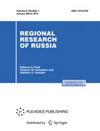数字化转型对俄罗斯某城市非食品零售空间组织的影响
引用次数: 0
摘要
摘要:本研究的目的是揭示在数字化转型的影响下,随着在线和离线“空间”或环境之间的选择的出现,零售/购买过程的“物理”空间结构发生了什么变化,以及电子商务如何改变俄罗斯城市组织非食品零售的“物理”空间原则,并以圣彼得堡为例。通过比较各种购物模式及其形成的时空系统,包括具体对象(仓库-商店、仓库-分销商、订单取件点和包裹终端)、零售主体与城市运输和物流流之间的互动特征,分析了新电子商务设施的布局原则。本文描述了新型零售设施布局的两种相反趋势:将交易功能转移到非交易场所和将非交易零售功能转移到零售场所。他们创造了与传统零售的空间竞争,以及与办公室和仓库业务类型的新的分层竞争。耐用品零售基础设施在步行距离之内的趋势,意味着一种新的地点竞争:与快速消费品卖家的竞争。在交付过程中,“最后一英里”的物流从消费者传递到卖家/物流人员,这一事实意味着商品流动的经济地理发生了根本性的转变。它不是私人自发的行人流量,而是形成了新的受监管的小吨位类型的“最后一英里”商业货物运输,使用替代运输方式(个人运输车)和运输路线(人行道、行人通道等)。所有这些都需要制定新的城市调控政策。本文章由计算机程序翻译,如有差异,请以英文原文为准。
Impact of Digital Transformation on the Spatial Organization of Nonfood Retail in a Russian City
Abstract — The objective of this study is to reveal what has changed under the influence of digital transformation in the “physical” spatial structure of the retail/purchase process in connection with the emergence of a choice between online and offline “spaces,” or environments, as well as how e-commerce has changed the “physical” spatial principles of organizing nonfood retail in a Russian city with a case study of St. Petersburg. The principles of placement of new e-commerce facilities were analyzed by comparing various shopping models and spatiotemporal systems formed by them, including specific objects (warehouses-stores, warehouses-distributors, order pickup points and parcel terminals), features of interaction between retail actors and transport and logistics flows in the city. Two opposing trends in the placement of new types of retail facilities are described: towards the transfer of the trading function to non-trading premises and the transfer of the non-trading retail function to retail premises. They create spatial competition with traditional retail as well as a new hierarchical competition with office and warehouse business types. The trend towards retail infrastructure for durable goods to be within walking distance means the rollout of a new type of competition for locations: with FMCG sellers. The fact that in delivery the logistics of the “last mile” passes from consumer to seller/logistician means a fundamental shift in the economic geography of goods flows. Instead of private spontaneous pedestrian flows, it forms new regulated small-tonnage types of “last mile” commercial cargo transportation using both alternative transport modes (personal transporter) and transport routes (sidewalks, pedestrian walkways, etc.). All these require the development of a new urban regulation policy.
求助全文
通过发布文献求助,成功后即可免费获取论文全文。
去求助
来源期刊

Regional Research of Russia
Social Sciences-Urban Studies
CiteScore
1.60
自引率
0.00%
发文量
21
期刊介绍:
Regional Research of Russia is the sole social science English-language journal focused on spatial development of Russia and its regions, and the post-Soviet states. The journal covers issues of economic and human geography, regional geography, regional economics and sociology, spatial planning, regional policy, urban and rural studies, and geography of resource management. The journal presents scientific results gained by researchers both in Russia and abroad. It aims to promote contacts between Russian and foreign regional specialists. Although articles are devoted to regional problems of Russia and the post-Soviet space, the journal welcomes contributions from all countries.
Regional Research of Russia publishes English translations of articles selected from three Russian academic journals:
Izvestiya Rossiiskoi Akademii Nauk. Seriya Geograficheskaya,
Izvestiya Russkogo Geograficheskogo Obshchestva,
Region: Ekonomika i Sotsiologiya.
and from other Russian-language journals on the case-by-case basis, as well as original papers. The source of each article is described at the article level on the title pages. The selection for Regional Research of Russia is made by the Editorial Board. Both original papers and the articles selected from other journals are peer-reviewed and subject to the same high standards for the quality of content, and publication ethics. The editorial policy is consistent for all parts of the journal. Currently most of the articles are from Russia, but the journal welcomes original manuscripts on regional problems in the English or Russian languages from all countries.
 求助内容:
求助内容: 应助结果提醒方式:
应助结果提醒方式:


